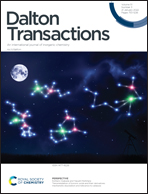Enhancing the phosphorescence decay pathway of Cu(i) emitters – the role of copper–iodide moiety†
Abstract
Speeding up the phosphorescence channel in luminescent copper(I) complexes has been extremely challenging due to the copper atoms relatively low spin–orbit coupling constant compared to heavier metals such as iridium. Here, we report the synthesis and characterization of three mononuclear copper(I) complexes with diimines, triphenylphosphine, and iodide ligands to evaluate the effect of the copper–iodide (Cu–I) moiety into the phosphorescence decay pathway. Temperature-dependent photophysical studies revealed combined thermally activated delayed fluorescence and phosphorescence emission, with a phosphorescence decay rate of the order of 104 s−1. Density functional theory calculations indicate very high spin–orbit coupling matrix elements between the low-lying states of these complexes. Compared to the classical [Cu(phen)(POP)]+, our results demonstrate that Cu–I is a versatile moiety to speed up the phosphorescence decay pathway in about one order of magnitude, and it can be prepared by a simplified synthetic route with few synthetic steps. Furthermore, the SOC matrix elements and the phosphorescence decay rates of these complexes are comparable to those of extensively applied coordination complexes based on heavier metals, making them a promising alternative as active layers of organic light-emitting diodes.



 Please wait while we load your content...
Please wait while we load your content...